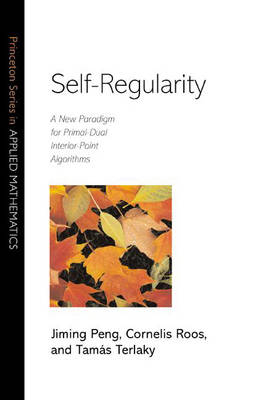
Self-Regularity
Princeton University Press (Verlag)
978-0-691-09192-1 (ISBN)
- Titel ist leider vergriffen;
keine Neuauflage - Artikel merken
Research on interior-point methods (IPMs) has dominated the field of mathematical programming for the last two decades. Two contrasting approaches in the analysis and implementation of IPMs are the so-called small-update and large-update methods, although, until now, there has been a notorious gap between the theory and practical performance of these two strategies. This book comes close to bridging that gap, presenting a new framework for the theory of primal-dual IPMs based on the notion of the self-regularity of a function. The authors deal with linear optimization, nonlinear complementarity problems, semidefinite optimization, and second-order conic optimization problems. The framework also covers large classes of linear complementarity problems and convex optimization. The algorithm considered can be interpreted as a path-following method or a potential reduction method. Starting from a primal-dual strictly feasible point, the algorithm chooses a search direction defined by some Newton-type system derived from the self-regular proximity.
The iterate is then updated, with the iterates staying in a certain neighborhood of the central path until an approximate solution to the problem is found. By extensively exploring some intriguing properties of self-regular functions, the authors establish that the complexity of large-update IPMs can come arbitrarily close to the best known iteration bounds of IPMs. Researchers and postgraduate students in all areas of linear and nonlinear optimization will find this book an important and invaluable aid to their work.
Jiming Peng is Professor of Mathematics at McMaster University and has published widely on nonlinear programming and interior-points methods. Cornelis Roos holds joint professorships at Delft University of Technology and Leiden University. He is an editor of several journals, coauthor of more than 100 papers, and coauthor (with Tamas Terlaky and Jean-Philippe Vial) of "Theory and Algorithms for Linear Optimization". Tamas Terlaky is Professor in the Department of Computing and Software at McMaster University, founding Editor in Chief of "Optimization and Engineering", coauthor of more than 100 papers, and an editor of several journals and two books.
Preface vii Acknowledgements ix Notation xi List of Abbreviations xv Chapter 1. Introduction and Preliminaries 1 1.1 Historical Background of Interior-Point Methods 2 1.1.1. Prelude 2 1.1.2. A Brief Review of Modern Interior-Point Methods 3 1.2. Primal-Dual Path-Following Algorithm for LO 5 1.2.1. Primal-Dual Model for LO, Duality Theory and the Central Path 5 1.2.2. Primal-Dual Newton Method for LO 8 1.2.3. Strategies in Path-following Algorithms and Motivation 12 1.3. Preliminaries and Scope of the Monograph 16 1.3.1. Preliminary Technical Results 16 1.3.2. Relation Between Proximities and Search Directions 20 1.3.3. Contents and Notational Abbreviations 22 Chapter 2. Self-Regular Functions and Their Properties 27 2.1. An Introduction to Univariate Self-Regular Functions 28 2.2. Basic Properties of Univariate Self-Regular Functions 35 2.3. Relations Between S-R and S-C Functions 42 Chapter 3. Primal-Dual Algorithms for Linear Optimization Based on Self-Regular Proximities 47 3.1. Self-Regular Functions in Rn+ + and Self-Regular Proximities for LO 48 3.2. The Algorithm 52 3.3. Estimate of the Proximity After a Newton Step 55 3.4. Complexity of the Algorithm 61 3.5. Relaxing the Requirement on the Proximity Function 63 Chapter 4. Interior-Point Methods for Complementarity Problems Based on Self-Regular Proximities 67 4.1. Introduction to CPs and the Central Path 68 4.2. Preliminary Results on P * (k) Mappings 72 4.3. New Search Directions for P * (k) CPs 80 4.4. Complexity of the Algorithm 83 4.4.1. Ingredients for Estimating the Proximity 83 4.4.2. Estimate of the Proximity After a Step 87 4.4.3. Complexity of the Algorithm for CPs 96 Chapter 5. Primal-Dual Interior-Point Methods for Semidefinite Optimization Based on Self-Regular Proximities 99 5.1. Introduction to SDO, Duality Theory and Central Path 100 5.2. Preliminary Results on Matrix Functions 103 5.3. New Search Directions for SDO 111 5.3.1. Scaling Schemes for SDO 111 5.3.2. Intermezzo: A Variational Principle for Scaling 112 5.3.3. New Proximities and Search Directions for SDO 114 5.4. New Polynomial Primal-Dual IPMs for SDO 117 5.4.1. The Algorithm 117 5.4.2. Complexity of the Algorithm 118 Chapter 6. Primal-Dual Interior-Point Methods for Second-Order Conic Optimization Based on Self-Regular Proximities 125 6.1. Introduction to SOCO, Duality Theory and The Central Path 126 6.2. Preliminary Results on Functions Associated with Second-Order Cones 129 6.2.1. Jordan Algebra, Trace and Determinant 130 6.2.2. Functions and Derivatives Associated with Second-Order Cones 132 6.3. New Search Directions for SOCO 142 6.3.1. Preliminaries 142 6.3.2. Scaling Schemes for SOCO 143 6.3.3. Intermezzo: A Variational Principle for Scaling 145 6.3.4. New Proximities and Search Directions for SOCO 147 6.4. New IPMs for SOCO 150 6.4.1. The Algorithm 150 6.4.2. Complexity of the Algorithm 152 Chapter 7. Initialization: Embedding Models for Linear Optimization, Complementarity Problems, Semidefinite Optimization and Second-Order Conic Optimization 159 7.1. The Self-Dual Embedding Model for LO 160 7.2. The Embedding Model for CP 162 7.3. Self-Dual Embedding Models for SDO and SOCO 165 Chapter 8. Conclusions 169 8.1. A Survey of the Results and Future Research Topics 170 References 175 Index 183
| Erscheint lt. Verlag | 27.10.2002 |
|---|---|
| Reihe/Serie | Princeton Series in Applied Mathematics |
| Verlagsort | New Jersey |
| Sprache | englisch |
| Maße | 152 x 235 mm |
| Gewicht | 425 g |
| Themenwelt | Mathematik / Informatik ► Mathematik ► Angewandte Mathematik |
| Mathematik / Informatik ► Mathematik ► Finanz- / Wirtschaftsmathematik | |
| ISBN-10 | 0-691-09192-7 / 0691091927 |
| ISBN-13 | 978-0-691-09192-1 / 9780691091921 |
| Zustand | Neuware |
| Haben Sie eine Frage zum Produkt? |
aus dem Bereich


